
Depicting the Mental Preparation of Heroes
Bujinga (Warrior Drawings)
Figures of samurai appearing throughout history, military epics and similar tales are powerfully depicted in the overwhelming ink brush paintings.
With bold yet sensitive brushwork and dynamic compositions, the works express the bravery of the heroes who are prepared to meet their fate. They radiate an aura that stirs the emotions of viewers and are full of spirit.
These works are created by Masayuki KOJO, a bujinga (warrior painting) artist.
The strong resolve, with which the warriors maintain their own unconventional faith, resides in the works created by Mr. Kojo, who constantly receives requests for collaboration.
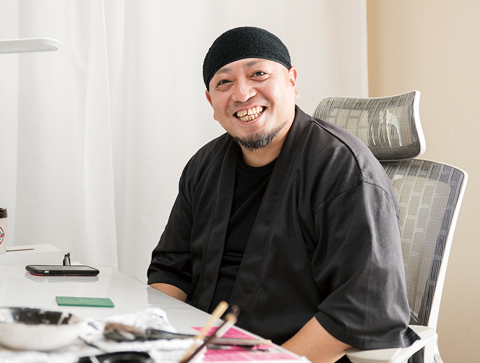
Masayuki KOJO, a bujinga artist
Born in 1978, Mr. Kojo is from Uji-shi, Kyoto. In 2014, he began his activities as a bujinga artist, drawing figures of warriors going through their resolve using Japanese sumi ink. His unique technique, which is unlike that of the traditional ink brush painting, and his distinctive, dynamic touch have been widely discussed. He has published a large number of collaborations, including the first-ever live performance in front of the Ninomaru Goten Palace of Nijo Castle, a national treasure, the calendar for the NHK epic drama Sanadamaru, and an official warrior drawing for the movie Star Wars. He also began to serve as the tourism ambassador of Uji-shi in 2018.
■ Official website: http://www.macfamily57.com
■ Online shop: http://www.collab-japan.jp (COLLAB JAPAN)
Everything I experienced on the baseball team and in the real world is the basis of my current activities.
Bujinga features motifs that are so dynamic that they seem to come alive from the frame mat, with an uplifting rush of energy. The drawings showcase heroes from history and military epics, such as feudal warlords. They also seem to express the consistent belief of warriors who do not flinch under any circumstances. “I depict the mental preparation of the warriors,” says Masayuki Kojo. He is a bujinga artist, who continues his creative activities based in his hometown of Uji-shi, Kyoto. Instead of musha-e (warrior prints), which are pictures of warriors based on historical facts, Mr. Kojo draws determined figures of warriors using only Japanese sumi ink. The impact of his works has earned high praise in Japan and overseas, resulting in a flood of offers. He designed the calendar for Sanadamaru, an epic samurai drama. This created an opportunity for him to make history with the first-ever live performance in front of the Ninomaru Goten Palace of Nijo Castle, a national treasure. Then, at an event commemorating the release of the movie, Star Wars: The Last Jedi, which was held at the Byodoin Temple, a UNESCO world heritage site, he exhibited a bujinga featuring characters from the movie, which were drawn on a huge folding screen. He attracts attention through these and other activities, which go beyond the framework of an artist’s usual activities.
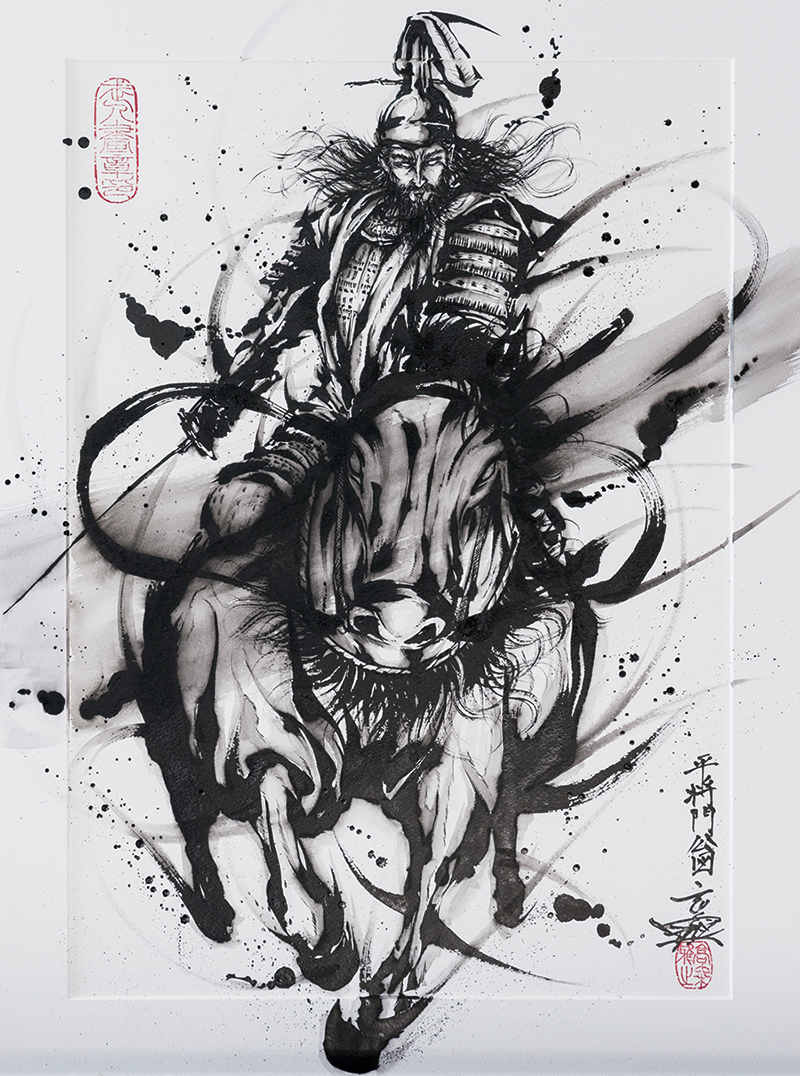
About four years ago, Mr. Kojo began to work as a bujinga artist in earnest. He enjoyed painting pictures, but had entered Ohmi High School (Shiga Prefecture), which is known for its competitive baseball team. Although his dream of being a regular player on the team did not come true, he volunteered to take a background role and continued to support the team. He later joined a delivery company, where he worked to improve the workplace environment and also contributed to increasing the company’s business performance. Mr. Kojo says, “On the baseball team, I tried to give primary consideration to what was needed for the team to win. At the company, I tried to consider what to do to resolve the complaints of co-workers or subordinates as a priority issue. Without these experiences, I would not have acquired the ability to see today’s trends and to research the needs of society or the ability to build a good, cooperative relationship with partners. Those experiences are also helpful for my activities as an artist.” His sheer desire to help others and his career as a high school baseball team member and office worker, unusual for an artist, form the foundation for his rapid success.
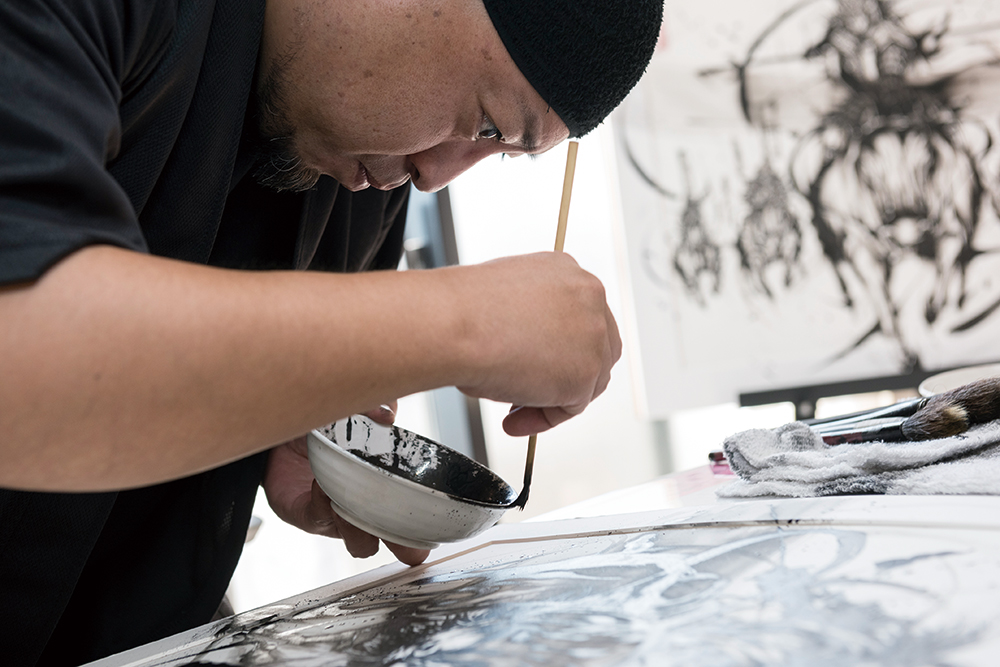
While continuing to want to be an artist, Mr. Kojo lived a care-free life as an executive officer of the delivery company, when he happened to see the TV commercial that changed his life. “An ink brush painting drawn by Takehiko INOUE was used in a TV commercial for Cup Noodles. Seeing that, I had a huge urge to draw the same things. Then, I decided to become an artist.” The following week, he submitted a letter of resignation to the company. With determination and action based on his belief in intuition, he took a major step toward starting a new chapter in his life.
Aspiration becomes the driving force for making dreams come true.
When he began to work as an artist, he says, “I was still an amateur.” His meeting with Eiji SAKAI, who heads Hoseido, a studio of ukiyo-e woodblock prints and Edo woodblock prints, later led Mr. Kojo to fame. He says, “A person who had seen authentic works of art judged my works with a keen eye. This enabled me to create more sophisticated work. The quality of my work improved thanks to the existence of a reliable partner who understood world-class art.” He independently established a technique that mixes the technique of ink brush painting with the expression of manga. This raised his profile even higher in the art scene and led to a breakthrough.
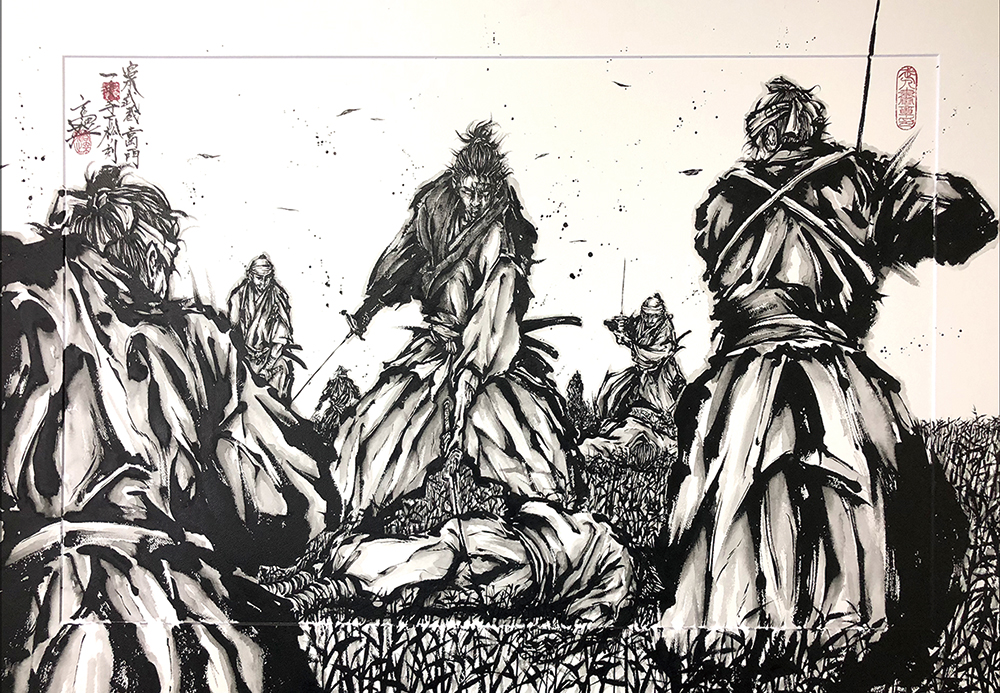
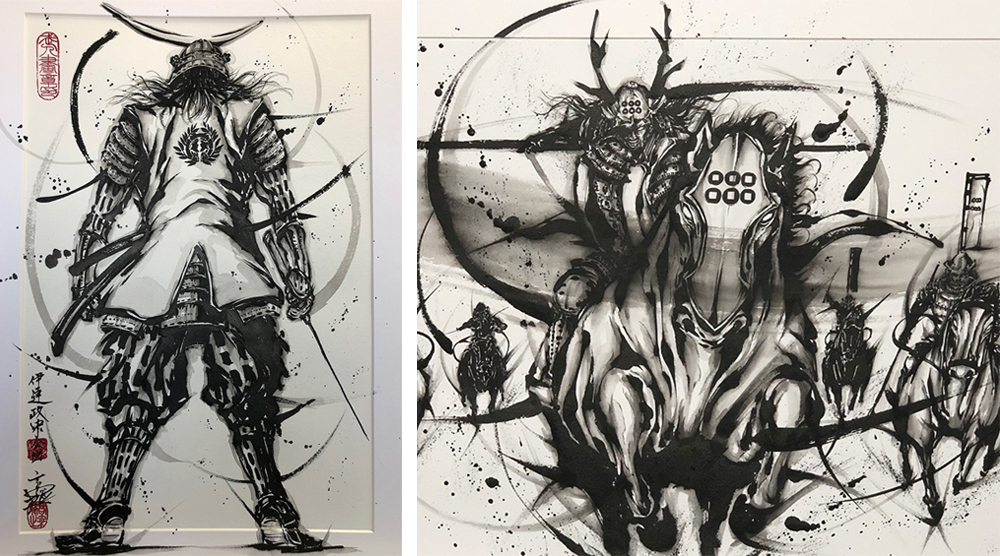
Top: Miyamoto Musashi Yoshioka Ichimon Ichijo-ji Sagari-Matsu no Koku (Musashi MIYAMOTO’s battle against the Yoshioka Clan at Ichijo-ji Sagari-Matsu), original bujinga (800 x 1,100 mm)/Lower right: Sanada Yukimura Ikki Tosen-no Zu (Yukimura SANADA the mighty warrior), original bujinga (660 x 850 mm)/Lower left: Date Masamune from the Otoko-no Senaka (men’s backs) series, original bujinga (605 x 455 mm)
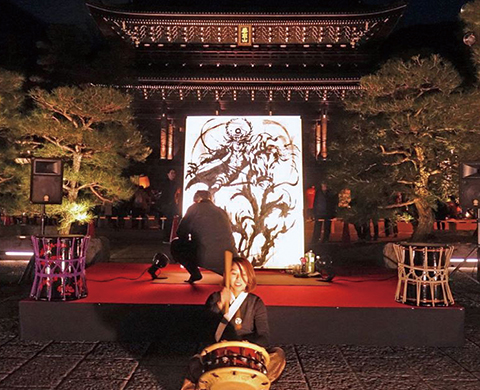
A photo of a live performance in front of Sanmon Gate at Chionin Temple. Mr. Kojo drew ink lines as if he were synchronizing his movements with the beat of the Japanese drum. This performance was part of the Kyoto Higashiyama Hanatoro 2018 event.
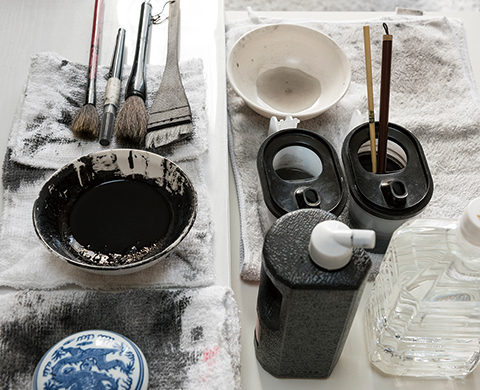
The tools that Mr. Kojo uses when drawing bujinga. They include a brush that his nephew used for the first calligraphy of the New Year.
In his works, Mr. Kojo uses Watson paper, which is Western paper used for watercolor painting, instead of the gasen-shi (Xuan paper) that is used for calligraphy and painting such as ink-wash painting. During live performances, he draws on the back of common coated paper. “I make it a rule to use affordable paper. Hand-made washi paper is so expensive that children who want to create similar paintings cannot readily do so, which makes it meaningless.” Other tools needed to create his works, such as ink brushes and water pitchers, are all commercially available products. For live performances, he chooses to wear clothes that do not cost more than 3,000 yen. In this way, he tries to open a path for young people who desire to be artists. “I want many children to imitate me.” Through his daily performances, Mr. Kojo continues to tell children the story of his long-held dream that came true by striving to get to where he wanted to be.
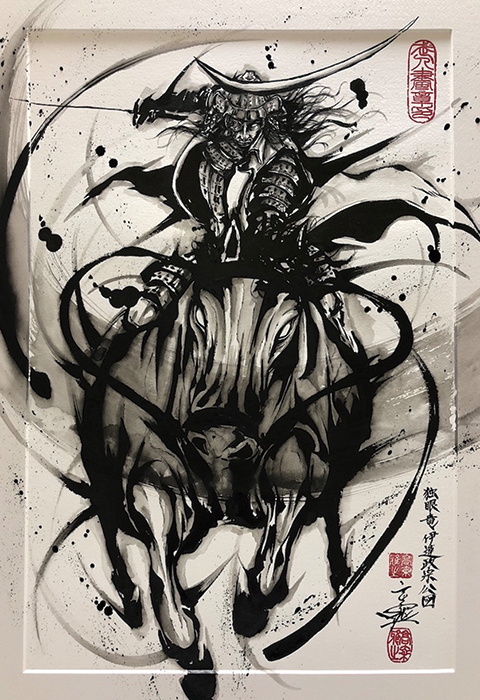
Dokuganryu Date Masamune Ko Zu (drawing of Masamune DATE, the one-eyed dragon) (660 x 850 mm)
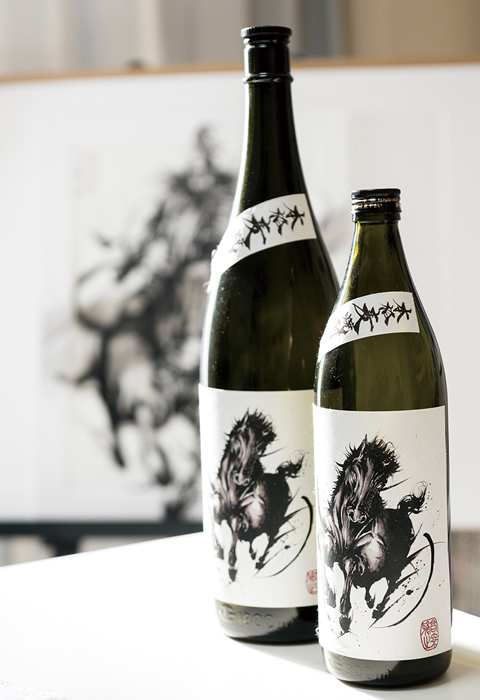
Bottles of Kurouma Amagake, a distilled spirit made from barley, from Kagura Shuzo Co., Ltd. in Miyazaki Prefecture. A black horse drawn by Mr. Kojo is used on the labels. He also wrote the calligraphy for the product name and appears in its TV commercial.
